In Ufokom, there has been an increasing number of inquiries regarding the identification of peculiar discoveries, many of which are shapeless fragments of melted metal, occasionally of considerable size. The individuals presenting these iron particles frequently speculate about their extraterrestrial source. There is widespread media coverage claiming that meteorites are “more precious than gold,” which has prompted esteemed Belarusians to search for them as if they were treasures, continuously bringing forth an array of stones that appear extraordinary to the common observer.
However, the majority of those surrendered to the “bureau of meteorite finds” at BelNIGRI turn out to be representatives of various groups of minerals that are quite earthly. These specimens are commonly referred to as pseudo-meteorites. While many people write about meteorites, very few mention them with the prefix “pseudo”. Meanwhile, Belarus adds about 10 new samples to its collection of pseudo-meteorites every month, while the collection of genuine meteorites has not seen a single addition in the past 20 years! This is the current situation where a critical mass of pseudo-meteorites has already accumulated, and the general population remains unaware. To prevent this critical mass from “detonating”, we have decided to “neutralize” it by creating a virtual tour of the museum, which is based on BelNIGRI and is led by its director, Vsevolod Evgenyevich Bordon. Bordon.
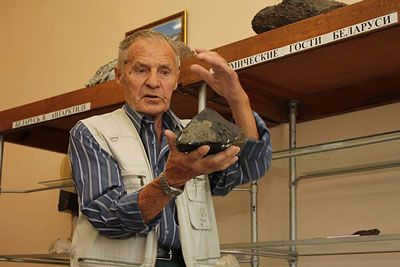
– Vsevolod Evgenyevich, can you please enlighten us on the common misconceptions about meteorites and provide some tips on how to differentiate between a genuine meteorite and a fake one without the need for laboratory analysis?
Every day, approximately 2 thousand tons of meteorites fall to Earth. Some of them end up in collections, while others disappear. The general population often brings us various alloys and rocks, hoping to determine if they have found a meteorite. Special tests are required to make this determination. Sometimes, a visual inspection of a sample is sufficient, but more often than not, additional tests are needed. Meteorites typically resemble charred rocks, with a black film or fusion crust on the surface from their journey through the atmosphere. Over time, the fusion crust may take on a red-brown color due to oxidation and weathering. However, people often bring in ordinary boulders, pieces of rock, foundry waste, swamp ore, or other types of ore. Most of the time, these turn out to be regular rocks that have been rolled around. It is only upon closer examination, such as washing the sample, that their true nature becomes apparent.
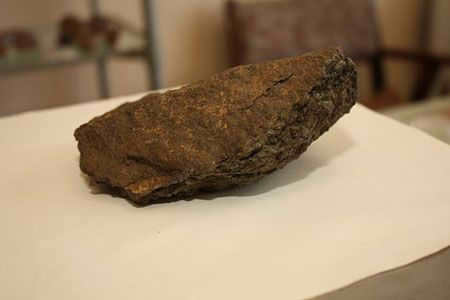

Pyroxinite. A piece of rock. How can we determine if it is pyroxinite? It lacks a fusion crust. There should be no crystals present in this rock. Photo: Evgeny Shaposhnikov (Ufokom).
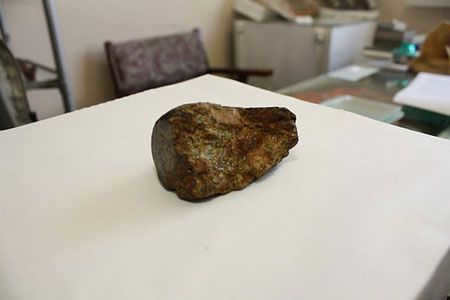
– Can you provide information on the future trends in terms of the “frequency of disposal” among the general population?
Coming in second are different types of foundry waste. Silicate iron is commonly found in this category, and it has a visually striking appearance when initially discovered. However, when the waste is collected for remelting, it often gets misplaced along the way. It can be found in unexpected locations such as forests, roadsides, and even vegetable gardens….
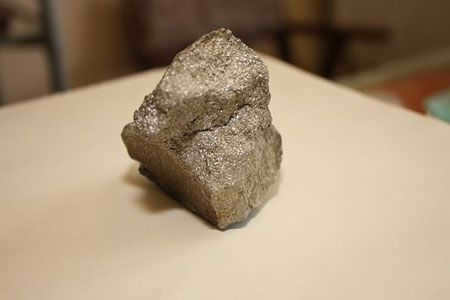
These are waste materials from the foundry industry, known as silicate iron or foundry waste. They are composed of silicates, which contain silicon, as well as both divalent and trivalent iron. The accompanying photograph was taken by Evgeny Shaposhnikov (Ufokom).
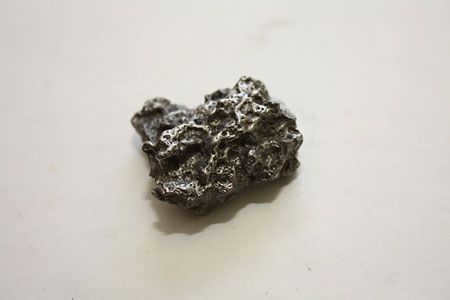
One of the specimens that Ufokom has received is now displayed in the BelNIGRI museum and represents a fragment of “foam” formed during the iron melting process. Photo: Evgeny Shaposhnikov (Ufokom).
– And what about the waste produced during the Bronze and Iron Ages by human activities? They must have been smelting something.
Indeed, it is possible, but we have not yet obtained such artifacts for the museum. It is relatively easy to determine their composition since they usually contain iron (Fe) and silicon (Si) in specific proportions.
The third position is currently held by remnants of shells and assorted bombs that remain from the two global conflicts. They bear a striking resemblance – metallic, fused, lying beneath the earth’s surface… Surprisingly alike, a few of them were indistinguishable to the naked eye – perhaps they are meteorites after all. However, we submitted them for a thorough examination, even to the laboratory of the Tractor or Motor Plant, where they possess the necessary equipment. The majority of them have been identified as Krupp steel (a form of armor steel) from a specific era.
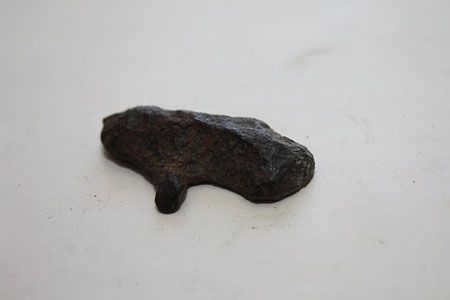
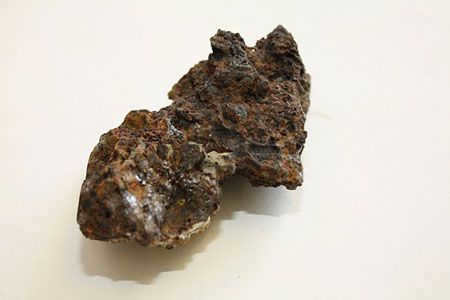
Occasionally, one may come across fragments of ancient shells that have been buried for such a long time that they resemble meteorites. Some of these fragments may even be remnants from the First World War. However, they do not possess a fusion crust, making it challenging to identify them individually.
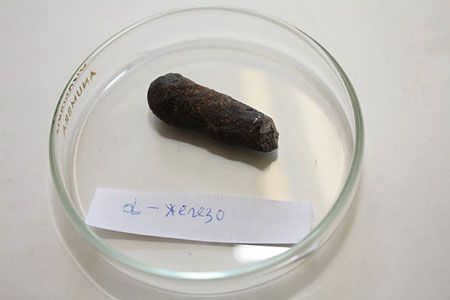

A gentleman arrived from Gomel yesterday, carrying two specimens. We conducted X-ray and spectral analyses, only to discover that they were not meteorites. The gentleman from Gomel expressed interest in taking back the samples, but I informed him that he would need to compensate me. However, he refused to comply. It is worth noting that the cost of the analysis is approximately 100,000 Belarusian rubles. Therefore, if you plan to transport your “meteorite” in the future, please ensure that you have this amount saved. Otherwise, it will be impossible to conduct any further analyses!
There exists an intriguing specimen that resided in the museum prior to my encounter with it, labeled as a fragment of the renowned Bragin meteorite. Skepticism arose within me due to the absence of a fusion crust, prompting me to submit it for analysis. Ultimately, the results unveiled its true identity as amphibolite, a composite rock comprised of hornblende and plagioclase. Consequently, it was allocated to a separate collection, this time designated for pseudo-meteorites.
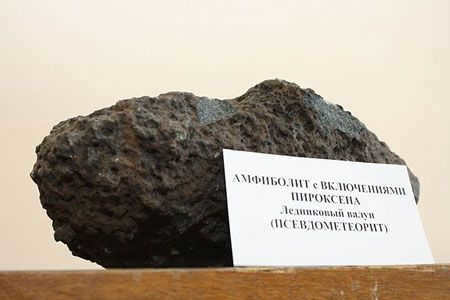

Scientists can also make mistakes. This meteorite had to be relocated to a nearby shelf categorized as pseudo-meteorites. Photo: Eugene Shaposhnikov (Ufokom).
Reference “MC”. The longest preserved Belarusian pseudo-meteorite – Ruzhansky, which we have previously discussed on our website. The fragment of this meteorite was stored at the Slonim local history museum for 20 years. After the war, S. I. Ryng from the Committee on Meteorites of the USSR Academy of Sciences determined that the sample stored in the museum was actually a boulder of sedimentary rock.
Physical Characteristics
Meteorites are classified into three main categories based on their composition: stone, iron, and ironstone. Stone meteorites are made up of silicate substances, while iron meteorites consist of monolithic pieces of iron-nickel alloy. Ironstone meteorites, on the other hand, are metal sponges filled with a silicate substance.
One distinguishing feature of meteorites is their weight, which is generally heavier than that of common minerals. Unlike slag, meteorites do not melt through and they do not have any bubbles, voids, or caverns inside. The surface of meteorites often exhibits regmaglypts, which are smoothed depressions resembling finger indentations on clay. Additionally, meteorites may have an aerodynamic shape.
When freshly fallen, meteorites have a fusion crust on their surface. Unlike slate sandstones or jasper-like rocks, meteorites lack layering in their body. They also do not contain carbonate rocks like chalk, limestone, or dolomite. Furthermore, meteorites do not contain any fossils, such as shells or fossilized fauna. Unlike granite, meteorites do not have a large crystalline structure.
Unique test
Iron ore is often confusing for prospectors and explorers. Magnetite, also known as magnetic ironstone (FeO-Fe2O3), has distinct magnetic properties that give it its name. Hematite (Fe2O3), another type of iron mineral, has similar but less pronounced magnetic properties.
How can you quickly and reliably determine whether you have magnetite or hematite? There is a simple and effective method called the “scratch test”. All you need to do is vigorously scratch your sample on the rough, unglazed surface of a white ceramic tile. If you don’t have a tile, you can use the unglazed surface of a sink or the bottom of a ceramic coffee cup. The idea is to have a rough, white ceramic surface.
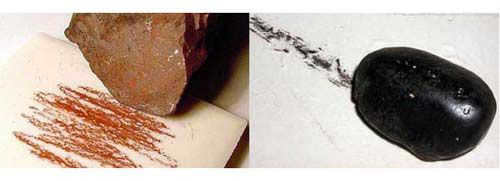
If the sample produces a dark or silver streak (similar to a soft graphite pencil), it is likely to be magnetite; if the streak appears vibrant red or brown, then you likely have hematite in your possession! A stone meteorite, if it has endured the fall and exposure to extreme temperatures, will not leave any marks on the surface of a tile. However, it is important to note that the scratch test, along with the other tests mentioned here, are only approximations (necessary but not sufficient conditions) and do not provide a definitive conclusion regarding the composition of your specimen.
The phenomenon of the “hot stone”
There is a phenomenon known as the “hot stone” effect. It is often observed that when using a metal detector, certain objects, particularly rocks, can give off a unique signal. In some cases, these rocks turn out to be stone meteorites. It is estimated that approximately 25% of the time, the metal detector reacts to these meteorites with a slight delay after passing over them. Interestingly, iron and ironstone meteorites are known to produce a very clear response from the instrument. This distinct reaction can help identify these meteorites among other types of rocks or minerals.
Sleep
This test will partially damage your sample! If your sample has successfully passed the previous tests, then the moment of truth is approaching – you need to create a small window on your sample to observe its internal structure.
The objective is to examine the inner structure. To accomplish this, create a cut on one side of the sample and, if possible, polish it. Carefully observe the exposed surface of the cut from different angles. If you observe shiny metal flakes scattered on the surface, your sample’s chances of being a meteorite increase. However, if the surface is smooth, fine-grained or coarse-grained, and lacks any traces of metal flakes, then the likelihood of it being a meteorite decreases significantly.
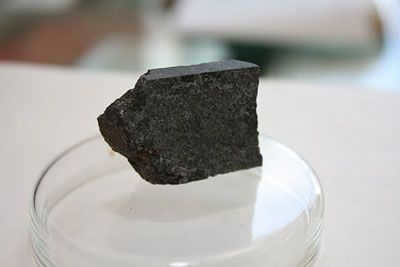
Nickel Testing
The presence of nickel is commonly found in all iron meteorites, indicating the presence of an iron-nickel alloy. Therefore, analyzing a sample for nickel can provide a conclusive identification of the sample’s composition. If you have reached this point, your determination is commendable. To determine the amount of nickel in a sample, a chemical test utilizing dimethylglyoxime is employed. This reagent can be obtained from a laboratory specializing in chemistry.
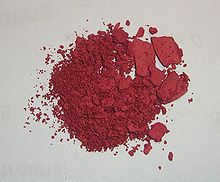
When you apply this organic compound (C4H8N2O2) onto the sample’s surface, a vibrant red solid will appear due to the reaction between dimethylglyoxime and nickel ions. It is important to exercise caution while conducting this experiment.
There is also an alternative method available: dissolving the medicine in industrial alcohol. By vigorously shaking one liter of alcohol, approximately a tablespoon of dimethylglyoxime can be dissolved, while a small amount of undissolved substance will settle at the bottom. After that, a regular sheet of paper needs to be taken and cut into strips that are 5 mm wide, similar to litmus papers used in tests. These strips should be wetted in the obtained solution and allowed to dry. A few drops of ammonia (or regular vinegar) should be dropped onto the sample, and after waiting a couple of minutes, the strip should be blotted with a test strip. If the strip turns light pink, it is likely that a meteorite has been found. If the strip remains white, the stone can be discarded or scrapped.
If you have any additional information about this publication, please contact us at [email protected]. Subscribe to our telegram channel to stay updated.
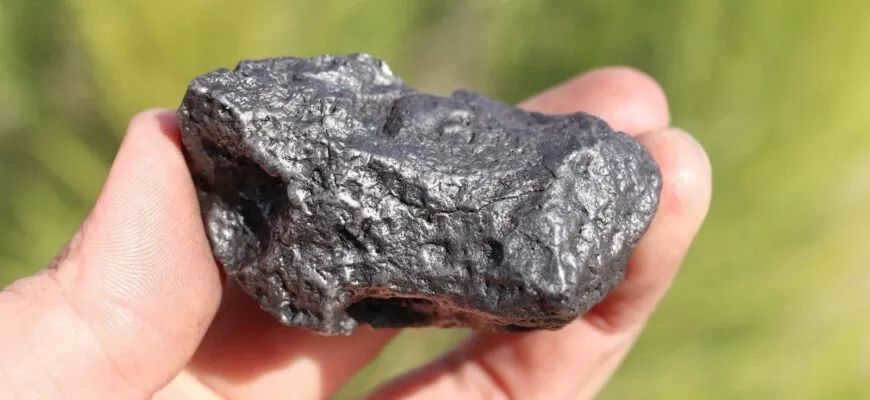
Many regular individuals consider discovering a “fallen star” to be an incredible and unbelievable event. However, “space visitors” (meteorites) are frequently discovered on our planet’s surface. Of course, these may not be as well-known as the Tunguska, Sikhote-Alin, or Chebarkul meteorites, which fell to Earth in 1908, 1947, and 2013 respectively. Nevertheless, it’s entirely possible to come across a fragment from a distant planet that accidentally made its way to us. All you need is a suitable metal detector for the job and a bit of luck. Many searchers dedicate significant amounts of time to hunt for such artifacts, as they not only hold valuable material but also provide valuable insights into distant worlds. Meteorites also hold a respectable market value.
Which meteorites can be detected by a metal detector
For every individual who has made the decision to embark on the journey of searching for meteorites, the question arises: how can one differentiate a “space alien” from an ordinary terrestrial stone? A metal detector is capable of detecting nearly all types of meteorites, which can be classified into three distinct categories:
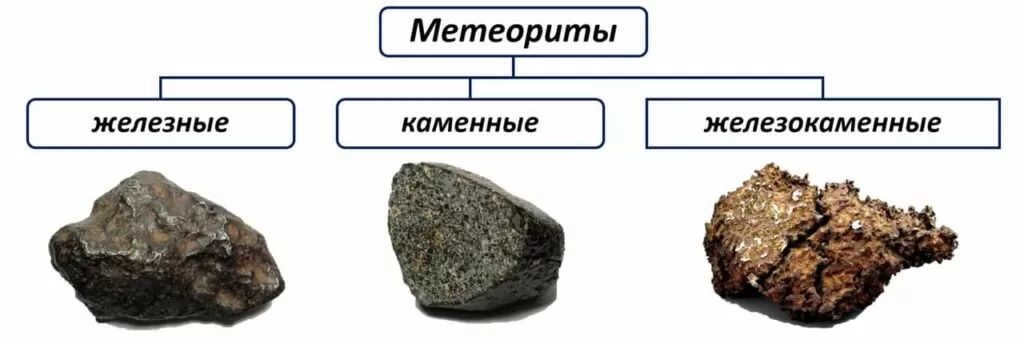
- Iron. These objects are representations of a single piece of metal. It is very seldom that it will be pure iron. Most commonly, nickel is present in their composition, and less frequently there are other types of metals.
- Ironstone. Various minerals are present in their structure, which can be visually identified as multicolored specks. They have an appearance similar to that of a metallic sponge.
- Stone. They are less prevalent compared to the others. Visually, they are almost identical to the most common stones, but upon closer inspection, small silicate balls called chondras and metal particles can be observed.
Typically, there are very few meteorites that consist entirely of stone. Almost all “extraterrestrial visitors” have metals within their structure. As a result, a metal detector will inevitably detect them. The key question is how strong and noticeable this detection will be. This primarily relies on the proper selection and configuration of the metal detector.

Tips for Locating Meteorite Impact Sites
It may be hard to believe, but meteorites are not as uncommon on our planet as one might think. While large meteorites, like the ones mentioned earlier, are quite rare, scientists estimate that more than a dozen tons of meteorites fall to Earth each day. These meteorites can vary in size, ranging from several kilograms to small particles. However, the challenge lies in the fact that they are spread out across the planet’s surface. This means that meteorites can fall not only in easily accessible areas but also in remote locations such as the taiga, deserts, Antarctica, the Arctic, and even the depths of oceans, seas, and lakes. Retrieving meteorites from these locations can be extremely difficult, if not impossible.
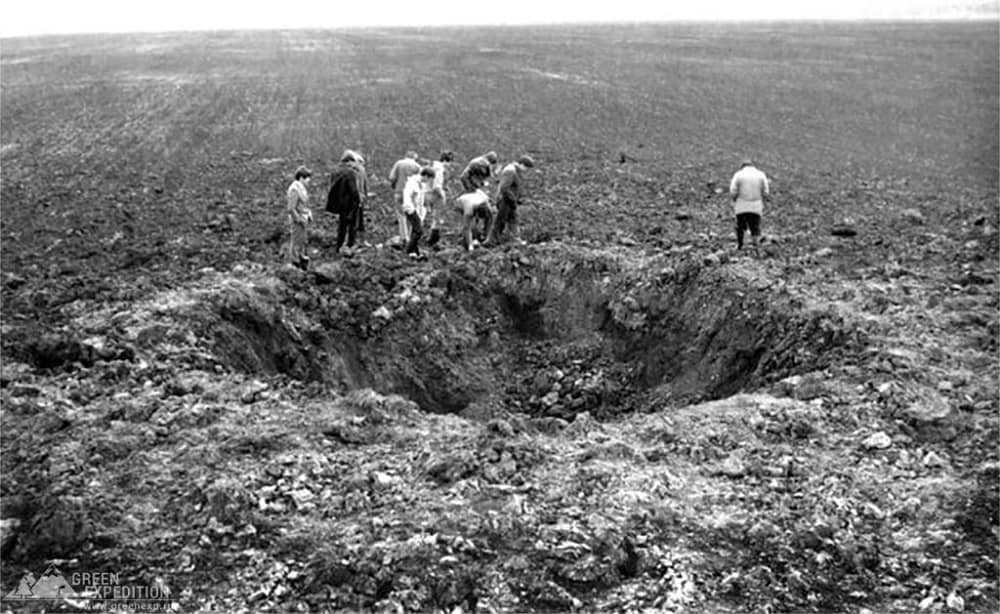
When looking for meteorites, it is advisable to focus on areas with sparse or no vegetation cover. However, it is important not to solely rely on luck. Prior to embarking on a search, it is recommended to conduct preliminary research and gather information. Official sources, such as scientific or news channels, should be the first point of reference. Additionally, forums and social media platforms may also contain messages about fallen meteorites or meteor showers. Historical accounts and ancient manuscripts can also serve as valuable sources of information regarding meteorite falls.
As previously mentioned, the majority of meteorites contain various metals. This means that almost any metal detector can be used for their detection, whether it be a basic and inexpensive model for beginner searchers or a more advanced detector with additional features. However, it is highly recommended to invest in a metal detector specifically designed for gold mining when searching for meteorites. These detectors are capable of detecting targets at significant depths, making them ideal for meteorite hunting. To make the search process easier, consider following these recommendations:
- It is advantageous to have a detector with an “All Metal” mode. This means that pulse metal detectors are more preferable than devices that operate on VLF or FBS principles.
- Take into consideration the weight of the detector. It is highly likely that you will be working for long hours during daylight, which typically ranges from 8 to 12 hours. The lighter the metal detector, the easier it will be to handle.
- A larger coil size allows for increased detection depth, but it may not be as sensitive to smaller objects. However, a “sniper” coil may not be the most ideal choice either. Opting for elliptical sensors with a diameter of 9″ to 11″ is recommended. For deep meteorite searches, consider purchasing an additional coil with a size of 15″.
Minelab, White’s, and XP Detectors are the most suitable models for meteorite hunting.
In addition to the metal detector itself, the following equipment will be necessary:
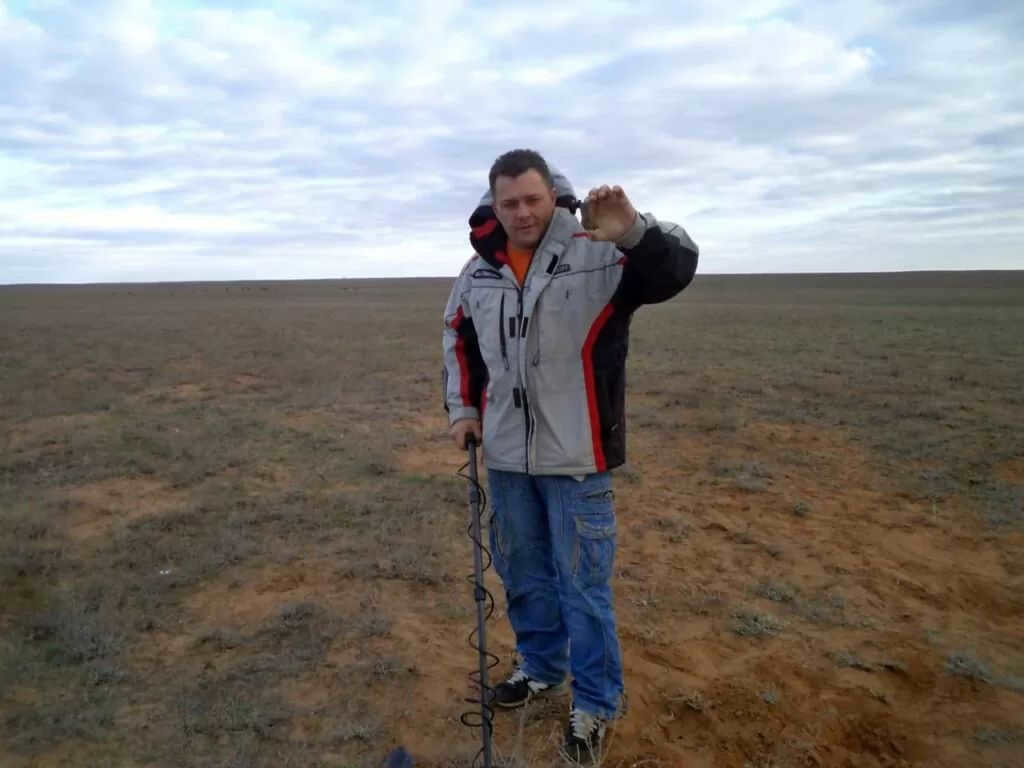
- headphones that have the capability to detect signals from even small targets buried at significant depths;
- a search magnet, which will enhance the effectiveness of the search;
- a shovel, pickaxe, or another tool that can be utilized for digging and for separating a piece of the meteorite for use as a specimen;
- protective gloves;
- a paint brush for cleaning dust and dirt off the surface of the stone;
- a magnifying glass that can be used to examine the structure of the object and confirm that it is indeed a meteorite;
- a headlamp to ensure that the search can continue even after darkness falls.
Ways to differentiate a meteorite from ordinary rocks and iron smelts
When beginning the search for meteorites, many individuals tend to collect any stone that appears suspicious, fearing that they may overlook a valuable and costly meteorite left behind in the field. To avoid this, it is important to be aware of the following indicators when identifying a potential “extraterrestrial” object.
- Composition: Meteorites often have a unique composition that differentiates them from regular rocks. They may contain elements that are not typically found in Earth’s geological formations.
- Magnetic Properties: Meteorites are often attracted to magnets due to their high iron content. This magnetic attraction can help determine if an object is a meteorite.
- Fusion Crust: A fusion crust is a thin, black, and often shiny layer that forms on the surface of a meteorite as it enters Earth’s atmosphere. This crust can be a key characteristic to look for when identifying a potential meteorite.
- Shape: Meteorites can have unique shapes caused by their descent through the atmosphere. They may have a rounded, melted appearance or exhibit features like regmaglypts, which are thumbprint-like impressions caused by the intense heat and pressure during entry.
- Weight: Meteorites are typically heavier than ordinary rocks of the same size. This is due to their high density and the presence of heavy elements like iron and nickel.
- Regmalipty are cavities and pits that form under high temperatures when a meteorite passes through the Earth’s atmosphere. However, the absence of regmalipty does not necessarily mean that a stone is not a meteorite. Sometimes, when a flying object explodes high above the Earth’s surface, small particles scatter in different directions like shrapnel. These rotating fragments will have irregular shapes and will be covered in regmalipty. On the other hand, pieces that do not experience rotational torque will resemble cones, bullets, or fang tips in shape. Additionally, the ends of these pieces will show traces of molten mass flying off as the meteorite rapidly descends. The tip of the cone will have a thin layer of melt measuring a few microns, while the opposite end can be as thick as a millimeter.
- If the stone has melted, deviates the compass needle, or is attracted to a magnet, you can attempt to polish a small section of it. To accomplish this, simply rub it with a file or sandpaper, and then treat this area with nitric acid. If it is indeed a meteorite, you will observe the distinctive Widmannstätten structure (a needle-like pattern composed of the minerals kamasite and tenite).
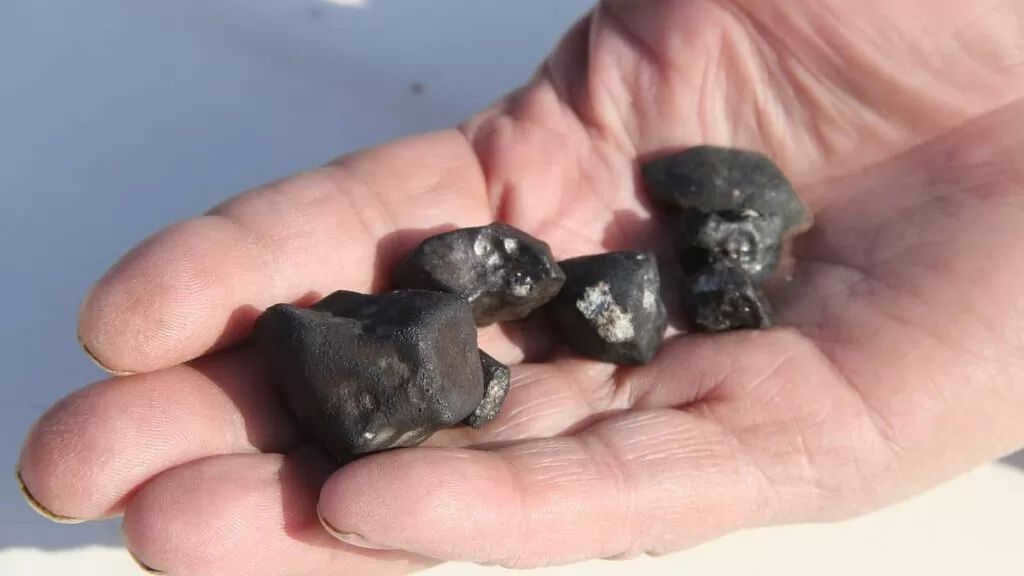
- As previously mentioned, these objects are characterized by a porous surface formed under high temperatures. Its interior should be compact and uniform. A completely porous structure, even if there are traces of fusion crust, indicates that you are dealing with a piece of slag.
- Collect the object you discovered. To determine if it is a meteorite, ensure that it is not composed of gypsum, chalk, feldspar, or any other fragile substances.
- Another easily verifiable indicator is weight. Meteorites have a significantly higher density, resulting in a relatively large mass. If you don’t have a scale, you can compare the object to a stone of equivalent volume as a simple test.
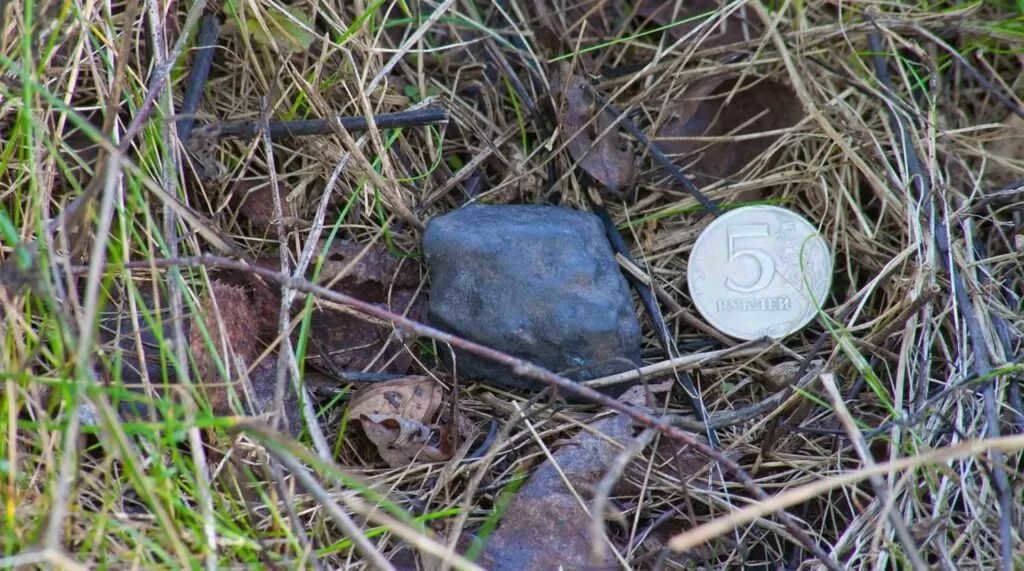
Even conducting such a relatively simple investigation will be sufficient to confidently determine whether you have discovered a genuine meteorite or just a regular stone, such as a piece of granite.
Legislation regarding the search for meteorites in Russia
While the search for archaeological and historical artifacts, relics, and rarities is regulated and overseen by relevant authorities, the search for meteorites is not prohibited. Meteorites are not classified as minerals, subsoil resources, or cultural heritage objects. Therefore, they are not owned by the state and a license is not required to search for them.
The only situation in which a license may be necessary is if you intend to sell, purchase, or exchange meteorite material. However, in our country, these activities can be conducted without any restrictions.
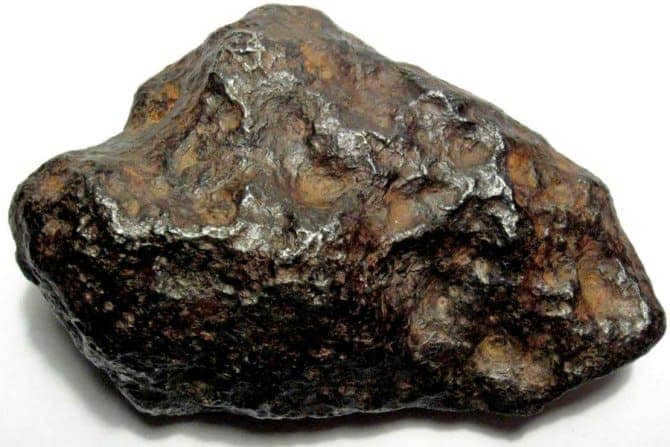
If you provide the Russian Academy of Sciences with information regarding the whereabouts of the finding and send them a small fragment of the meteorite, weighing just 10-15 grams, the scientific community in Russia will greatly appreciate your contribution. Furthermore, the Russian Academy of Sciences has been presenting awards to individuals who accomplish this since 2003. At times, the value of the prize can exceed 10,000 rubles.
Summary
If a treasure hunter interested in finding meteorites has some knowledge about them and the necessary equipment, they have a good chance of discovering something remarkable. Even a simple stone they come across could be a “visitor from outer space”. It’s up to the hunter to decide what to do with their find. Once in the hands of scientists, these meteorites can contribute to significant discoveries about the universe’s structure and composition. They can also bring wealth, as meteorite fragments are often used in jewelry instead of precious stones. For instance, a well-known watchmaking company has created a unique timepiece called the Speedmaster Professional Apollo-Soyuz, which features dials made from meteorites, making them truly one-of-a-kind.
Black diggers on the African continent made an incredible discovery when they stumbled upon the extraordinary Black Beauty meteorite, but unfortunately, they unintentionally erased its valuable data just like the memory-wiping agents in the Men in Black movies. Believe it or not, these individuals who search for remnants of celestial phenomena are unknowingly erasing billions of years worth of history from the solar system. This article explores the reasons behind the disappearance of meteorite memory, offers suggestions on how to prevent it, and provides guidance for anyone who happens to stumble upon a “stone from the sky”.
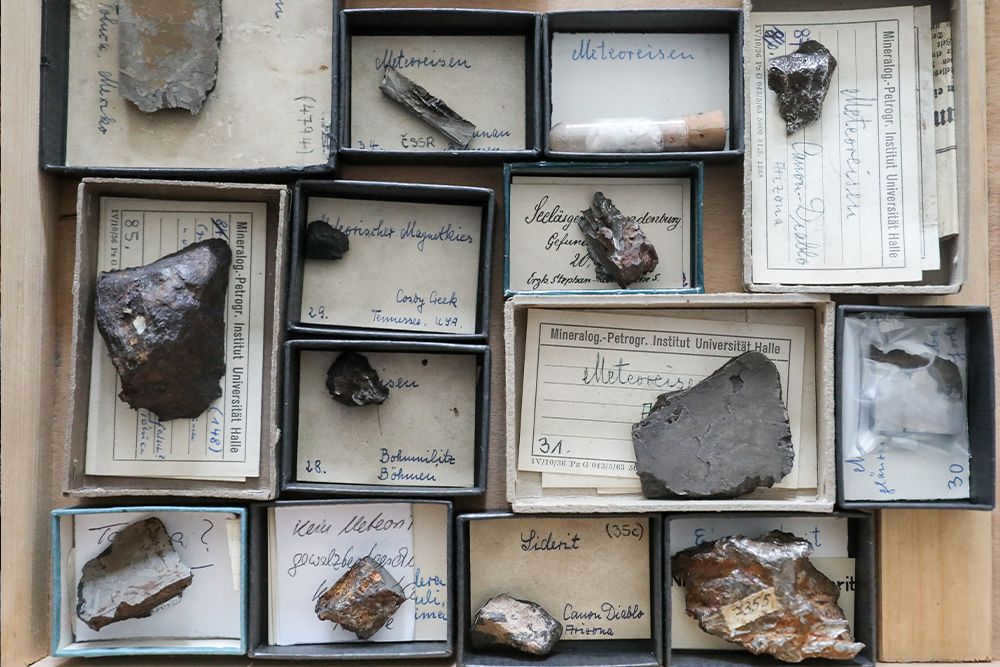
In the pursuit of a celestial body
For some individuals, searching for meteorites is a way to experience the thrill of being like Indiana Jones and connect with the vastness of the universe. For others, it is an opportunity to contribute to scientific research, while for some it is a quest for substantial financial gain. Magnetic properties serve as a crucial tool for hobbyists to distinguish chondrites (the most common type of meteorite) from ordinary rocks or charred bricks. A metal detector or a “magnetic staff” – a stick equipped with a powerful neodymium magnet at its end – becomes an indispensable companion in the search. The use of such magnets is endorsed globally by meteorite hunters, universities, geologists, and television programs. However, scientists have discovered that meteorites that hold significant scientific value, such as Martian or lunar meteorites, often contain a low percentage of iron and are not strongly attracted to magnets – in fact, magnetic forces can cause damage to them.
A recent study published in the Journal of Geophysical Research: Planets has demonstrated the effects of neodymium magnets on a sample with a magnetic field strength 10,000 times greater than Earth’s. The study, conducted by MIT planetary scientist Foteini Vervelidou, reveals that these magnets have the ability to “erase” residual magnetic fields found in iron-containing minerals and rewrite them by altering the strength and orientation of magnetization. This phenomenon was confirmed through the examination of 13 basalt samples, a type of rock that is also attracted to magnets and can potentially mislead researchers. As a result of this research, scientists now have complete certainty regarding the side effects of magnets that have long been suspected.
As per the researchers, numerous discrepancies in scientific papers can be accounted for by this phenomenon: for instance, the presence of erroneous information regarding the most powerful magnetic field found on asteroids, as seen in certain publications discussing the extensively examined meteorite Allende, which descended in Mexico in 1969. Regrettably, there is currently a lack of further investigation and acknowledgment within the scientific community regarding this matter, despite the utilization of magnets in the Antarctic meteorite exploration initiative known as ANSMET.
Chunks of Mars discovered in the Sahara Desert
A major letdown for scientists came in the form of the Martian meteorite known as “Black Beauty” or Northwest Africa 7034. Its rocks date back 4.4 billion years – a piece of the oldest crust, only a few tens of millions of years younger than Mars itself. This meteorite broke away from Mars 5-10 million years ago due to the impact of another celestial body. Machine learning algorithms, analyzing tens of thousands of images from the Mars Reconnaissance Orbiter camera, suggest that the likely result of this impact is the Carratha crater located in the southern hemisphere of Mars. Roughly a thousand years ago, fragments of Black Beauty landed on Earth, and in 2011, some of these pieces were discovered by Sahara Desert nomads.
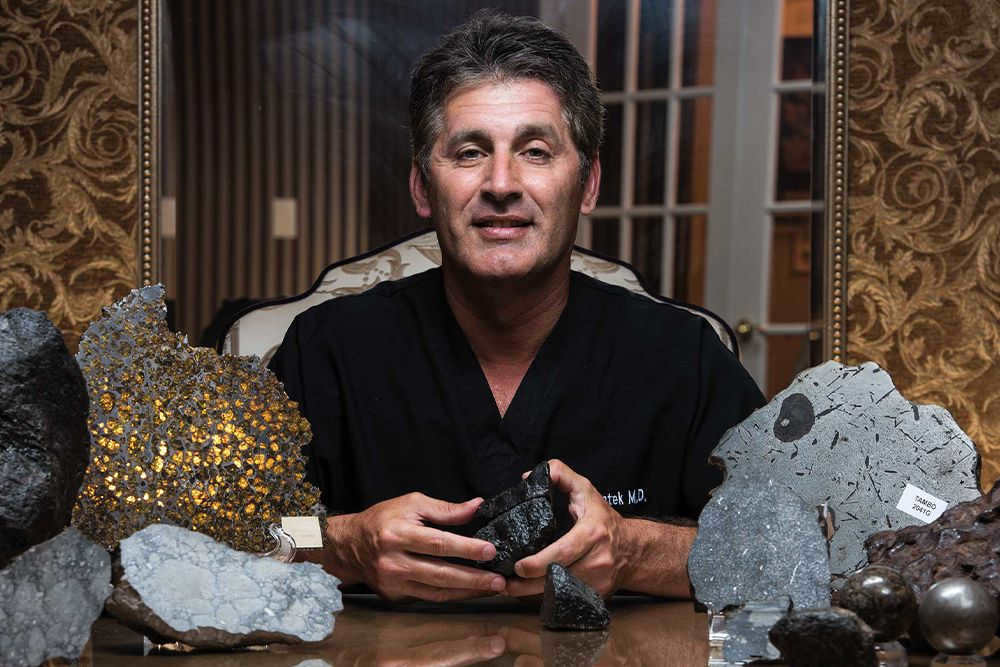
Jay Piatek has repurchased around two-thirds of the total weight of the “Black Beauty” shards, which are among the 75 known meteorites originating from Mars.
Originally, the meteorite had been acquired by Jay Piatek, the owner of a weight loss clinic in Indianapolis. When Piatek sent the discovery to scientist Karl Agee for examination, there were doubts about its authenticity. However, it was later revealed that the unattractive stone, which appeared to be coated with spray paint on the outside, actually resembled lunar rock breccia in its composition. It contained white crystals of feldspar and dark inclusions of pyroxenes. The manganese to iron ratio provided clear evidence of its origin.
The past and future of Mars can provide valuable insights into the ancient history of Earth, which has been largely erased by natural forces such as precipitation, wind, water, and living organisms. It is no wonder that Jerome Gattaccheca from the European Center for Research and Teaching of Earth Sciences was eager to uncover important details about Mars’ magnetic field, which was once strong but is now on the brink of extinction, from the fragments of the Black Beauty meteorite. Unfortunately, this 4 billion year old record has been erased due to the use of powerful magnets by meteorite hunters.
Meteorites are subject to legal regulations
In Morocco, individuals seeking fragments of the “Black Beauty” meteorite must contribute 20% or 20 grams (whichever is less) of each piece for scientific research. However, in Russia, the situation is different. Meteorites are not legally classified as treasures or finds, as they do not have an owner even if they hold significant value. According to the “On Subsoil” Law, if legal entities or individual entrepreneurs discover a meteorite while mining, collecting, or constructing something, they must halt their activities and inform the relevant authorities who issued the license. For ordinary citizens who stumble upon a meteorite, lawyers recommend reporting the discovery to local authorities. However, it remains unclear who would claim ownership as the state’s ownership of subsoil resources does not explicitly include meteorites. In the pre-revolutionary era, meteorites would have belonged to the Russian Empire, but today they are ironically closer in legal status to berries and mushrooms.
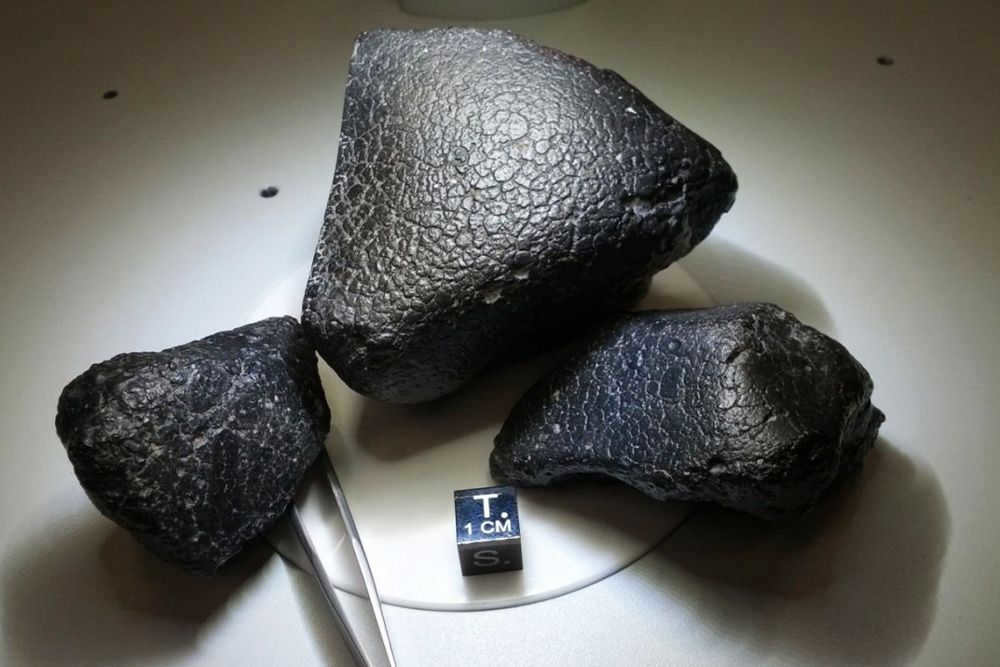
There are two situations in which violating the law can result in consequences. Firstly, if someone sells regular stones masquerading as celestial bodies, it will be considered as fraud (as seen in a previous case). Secondly, if a meteorite is found to be radioactive, individuals can face up to two years of imprisonment for “illegally handling nuclear materials or radioactive substances”. Moreover, individuals can also draw the attention of law enforcement by stealing exhibits from museums, as was the case with a geologist who sawed off and took a piece of the Chelyabinsk meteorite.
There is limited information available on the sale and future destiny of discovered meteorite fragments, and Russian enthusiasts for “shooting stars” are capitalizing on this situation. Some individuals offer guided tours to Chebarkul, enticing visitors with the opportunity to discover meteorite fragments. Others are selling supposed fragments of the Chelyabinsk meteorite for prices ranging from 500 to 142 million rubles. In a puzzling turn of events, one individual managed to steal the Segezha meteorite, which weighs over a ton, from the depths of Vygozero in Karelia with the assistance of divers and an underwater pump. It remains unclear whether this individual intends to sell the meteorite or add it to their personal collection.
Preserving the Essence of “Magnetic Memory”
Researchers hold a positive view towards meteorite hunters as they themselves often lack the necessary resources to search for particles within a radius of tens or even hundreds of kilometers. Additionally, the data regarding the location of a fragment is highly valuable as it aids in constructing models to forecast the impact of celestial bodies falling from the sky.
However, the question arises: how can one search for meteorites without causing any harm? Vervelidoux and her colleagues propose the substitution of neodymium magnets with magnetic susceptibility meters. These devices employ a weak magnetic field that does not erase the memory of meteorites and offers a significantly higher level of accuracy in determining their classification. Presently, Jerome Gattakkeka is in the process of developing more user-friendly and accessible versions of such devices, which will be available at a fraction of the cost.
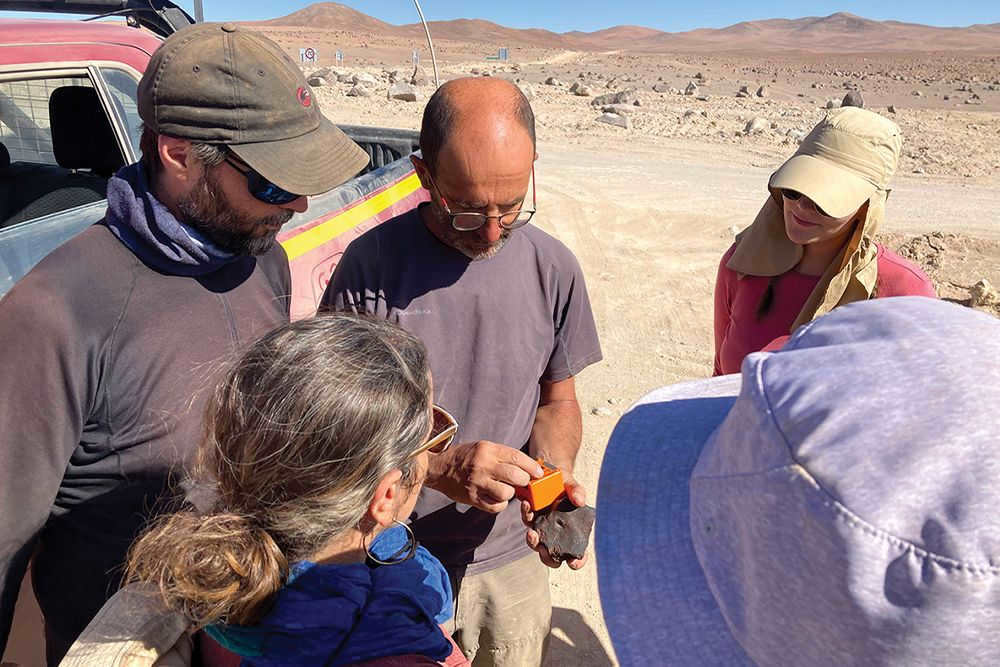
Up until now, researchers have been attempting without success to convince individuals in Morocco, who are gathering the final remnants of the Black Beauty in the Sahara desert, to refrain from using magnets. In the case of Russia, these devices are also not accessible to everyone due to their high prices, but those who are dedicated to finding meteorites can choose to rent them.
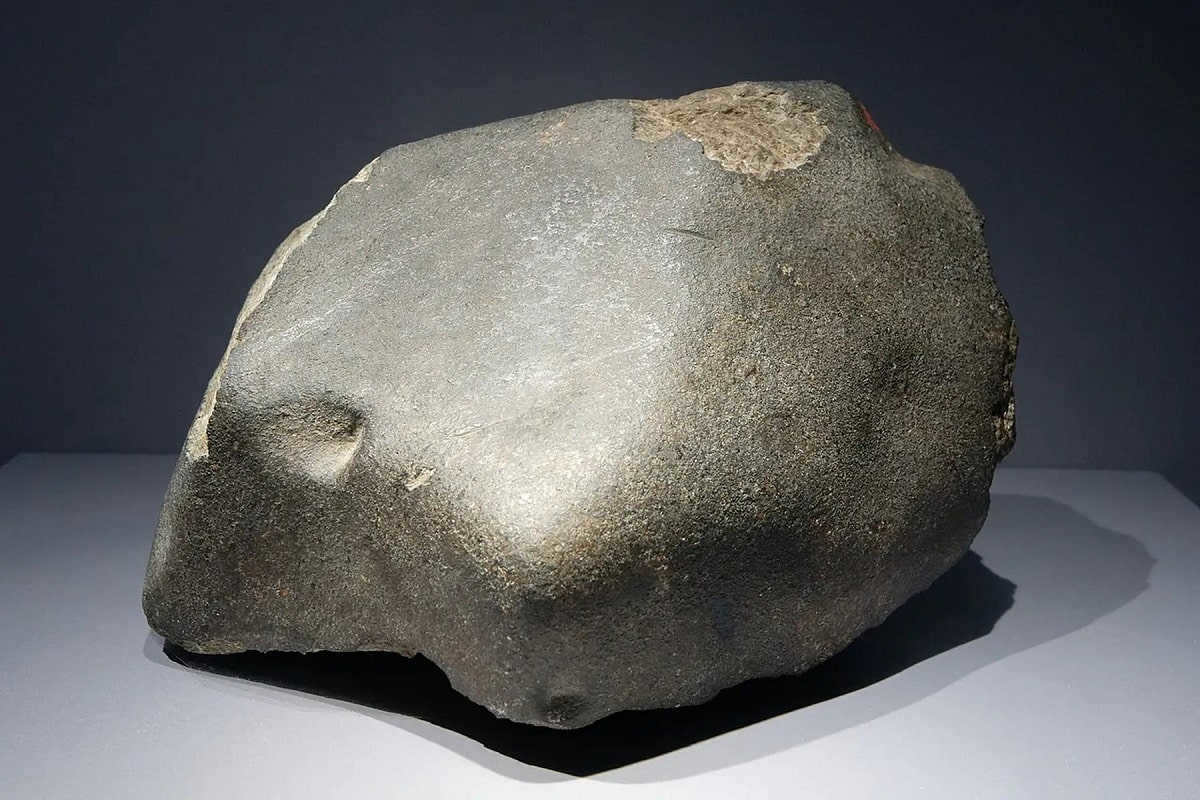
Meteorites are large rocks that enter the Earth’s atmosphere and eventually land on the Earth’s surface. However, it can be challenging to determine whether a large rock is a meteorite or simply a regular rock.
In this article, we will provide you with information on how to identify a meteorite and distinguish it from other rocks. We will discuss its characteristics and origin to help you determine if what you have found is indeed a meteorite.

Meteorites frequently plummet to Earth from the vastness of space. Typically, they descend into the depths of the ocean or unpopulated areas, making it exceedingly challenging to locate fragments of asteroids anywhere. However, if you chance upon a peculiar rock in an area of interest, there are several techniques you can employ to determine if it possesses extraterrestrial origins.
A ferromagnetic meteorite can be detected by its attraction to a magnet. If the rock fails to adhere to the magnet upon approach, it is likely not a ferromagnetic meteorite. It is worth noting that only meteorites that exhibit magnetic properties are classified as ferromagnetic.
Rhegmaglypts, which are surface formations found on black or brown rocks, are another indicator of a meteorite. Almost all black rocks possess a darker hue than ordinary rocks and display these distinct surface markings. Additionally, weight is a commonly observed characteristic. Meteorites tend to be remarkably heavy, with a density ranging from 4 to 8 grams per cubic centimeter.
If you are still uncertain, you have the option to polish the stone using water-based or paste sandpaper. Meteorites tend to acquire a metallic appearance after being polished. Once an asteroid is discovered, it ought to be sent to the geology department for further examination. Various tests are conducted to verify if the asteroid is truly what it claims to be (a fragment from a fallen asteroid). If the asteroid successfully passes all of the aforementioned 9 tests, it is considered authentic.
Between Mars and Jupiter lies the region where some speculate a planet once existed but was destroyed during the solar system’s formation. The asteroid belt is believed to have formed from millions of small rocks and stones, with millions of debris fragments hiding behind it. Occasionally, one of these asteroid fragments deviates from its orbit and collides with Earth.
Ways to Determine if an Object is a Meteorite
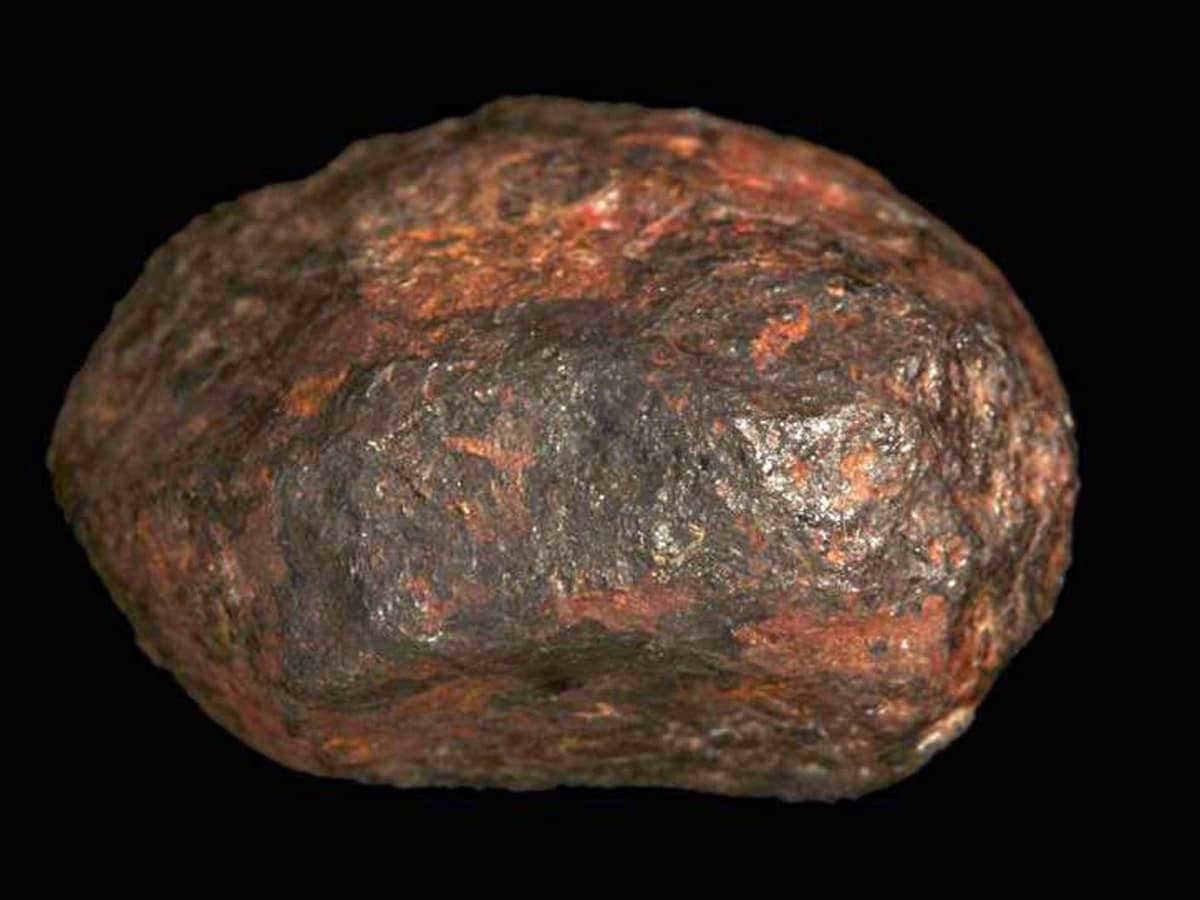
fusion crust
The dark substance surrounding a meteorite, if it did not fracture upon impact, is what sets a meteorite apart from other fragments that we may come across. The outer layer of rocky meteorites is typically thicker than that of metallic meteorites, usually less than 1 mm in thickness.
The outer shells of rocky meteorites consist of non-crystalline silica (a type of glass) mixed with magnetite that originates from the silicates and iron found in most rocky meteorites.
The external layer of metallic meteorites is primarily composed of an iron oxide known as magnetite, which is typically less than a millimeter in size. They are often influenced by various atmospheric factors and if left unnoticed on the ground for an extended period of time, they will develop a rusty appearance.
These are formations observed in the crusts of certain rocky meteorites that give them a cracked appearance. They are the result of the rapid cooling of the Earth’s crust from the extreme temperatures generated by friction to match the surrounding atmospheric temperature, which can sometimes be below freezing. These cracks play a significant role in the subsequent erosion of meteorites.
Meteorites in space have the ability to rotate or maintain a linear trajectory, and as they pass through the atmosphere, they can experience sudden changes or continue on their original path until they reach the ground. This is what causes them to undergo transformations in their appearance.
Meteorites that undergo rotation upon impact will not exhibit a consistent weathering pattern and therefore will have an irregular shape. On the other hand, meteorites that do not rotate will maintain a stable orientation during impact, resulting in the formation of a cone shape with predominant erosion lines.
Angular Meteorites
The angular meteorites have surfaces that consist of shapes with angles measuring between 80-90 degrees. These shapes have rounded tops and edges, and are often defined by broken lines.
Rhegmaglyphs: These are notches that form on the surface of meteorites in a spherical manner. They appear conical due to the way they fall through the air. Metallic meteorites are the most commonly found type.
Flight lines: When a meteorite falls, its surface is subjected to extreme temperatures, causing the material to melt and behave like a liquid. As the meteorite cools during its descent, the molten material solidifies, forming flight lines on its crust. The orientation and rotation of the meteorite also play a significant role in determining its shape, in addition to its composition.
Color and Powder
When meteorites are fresh, their color is typically black, and their fusion crusts display current lines and details that aid in their identification. Over time, as they lie on the ground, meteorites undergo color changes and their fusion crusts wear away, causing the details to fade. Similar to iron tools, the iron within meteorites can undergo oxidation due to weathering. When ferrous metal oxidizes, it contaminates both the inner matrix and the outer surface of the rock. This process begins with the appearance of red or orange spots within the molten black crust. Eventually, the entire rock will take on a rusty brown hue. The molten crust may still be visible, but it will no longer appear black.
If we take a piece of the meteorite and rub it against the back of a tile, the resulting dust can provide a clue: if the dust is brown, it indicates that we may be dealing with a meteorite; if it is red, then we are likely dealing with hematite; and if it is black, then it is likely magnetite.
Additional general traits
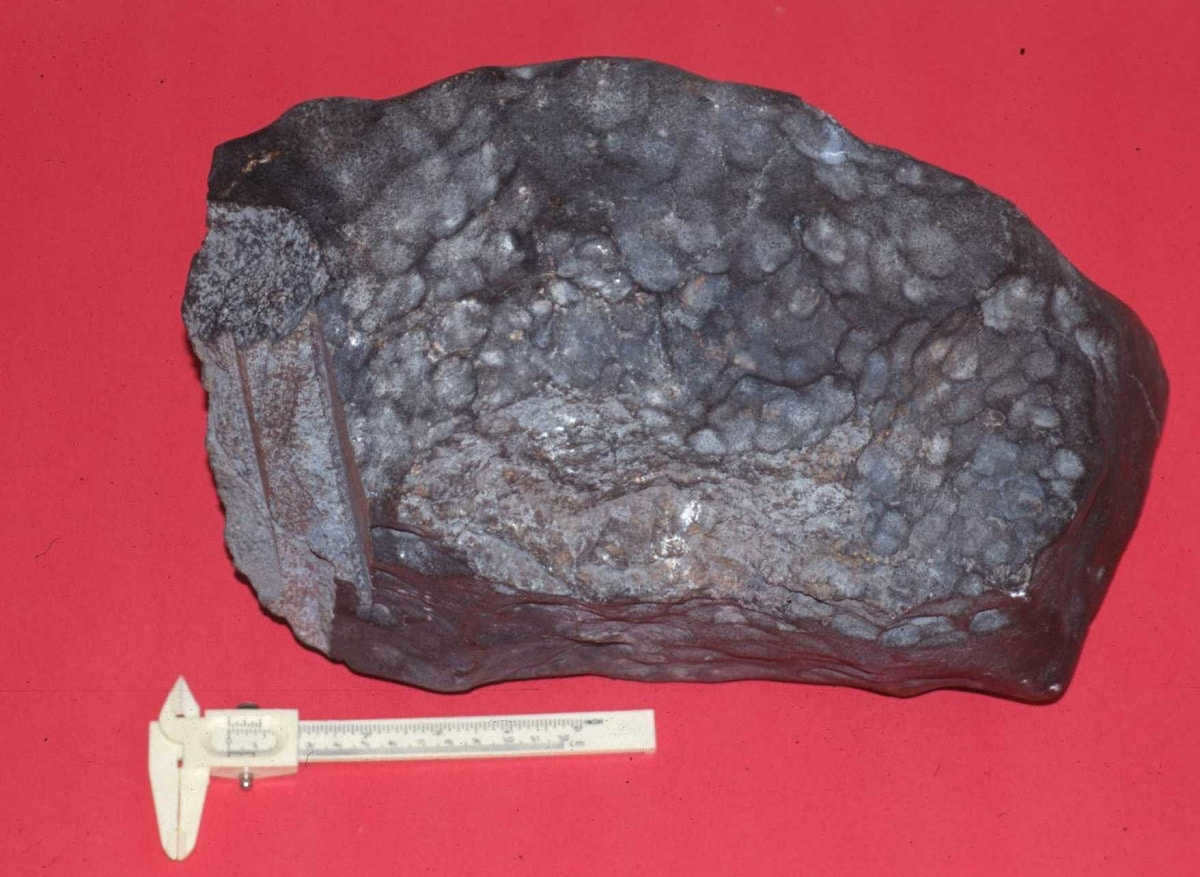
When identifying meteorites, it is important to consider several characteristics that set them apart from other rocks:
- Meteorites lack quartz.
- Meteorites typically have dark colors, such as black or brown, as they have been altered by oxygen.
- Streaks on meteorites are usually colorless and white.
- Meteorites do not have air bubbles or cavities, and 95% of them are composed of cinder.
- Metallic meteorites are strongly attracted to magnets.
I trust that this information will provide you with a deeper understanding of distinguishing between a meteorite and other objects.
The contents of this article adhere to our guidelines on editorial ethics. If you spot any errors, please click here to report them.
Full article path: Network Meteorology " Meteorology " Release " Determining the Authenticity of a Meteorite
Write a comment, leave your thoughts
Share your opinion Cancel your response
Stop and refrain uttered
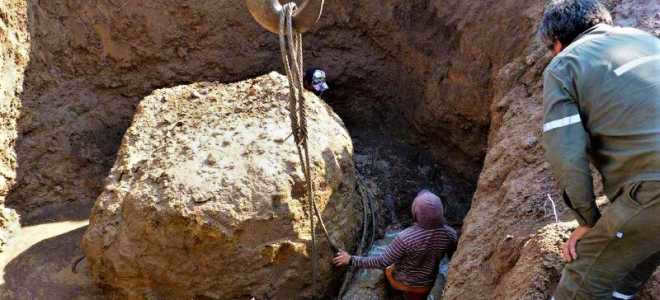
What makes the search for meteorites important for humanity? Primarily, it piques our interest and curiosity. Additionally, it is a significant contribution to scientific progress. Furthermore, surprisingly, it can be quite a profitable pursuit.
By now, it is common knowledge where meteorites originate from. They come to us from outer space, and when they land on Earth’s surface, the planet’s inhabitants started discovering them. Initially, each found meteorite was seen as a universal marvel, but in today’s world, there are plenty of professional hunters of celestial bodies.
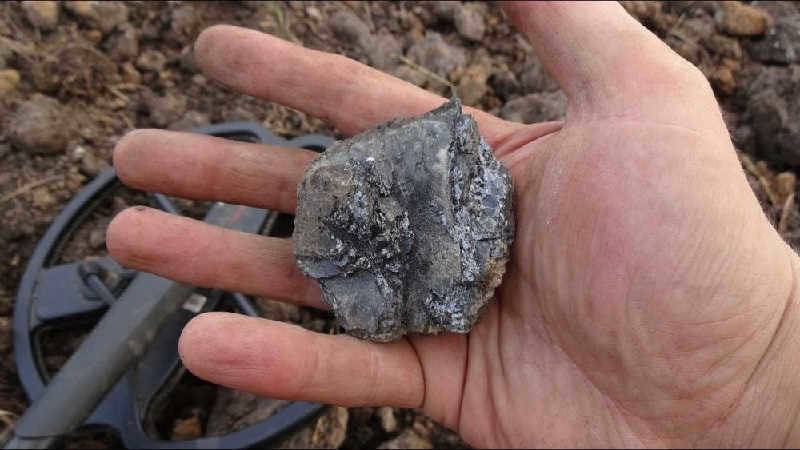
Importance of Meteorite Study
The study of meteorites is crucial for scientific research and our understanding of the world around us.
In fact, scientists examine meteorite fossils and minerals to gain insights into the origins of planets and other celestial bodies. Meteorites may hold the key to answering this question, providing us with a deeper understanding of our universe.
Furthermore, the examination of meteorites has revealed their intricate and complex structures, which have formed over an extensive period of time. Additionally, these findings can help determine the nature of their origins, whether they come from asteroids, comets, planets, or other celestial bodies.
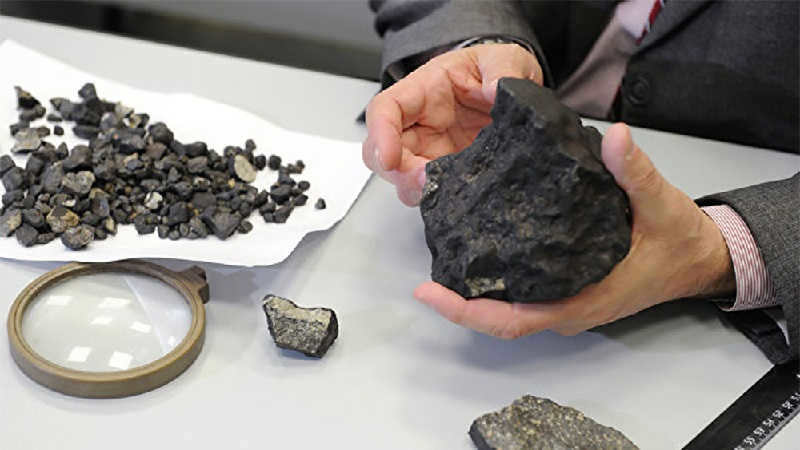
Furthermore, the Earth could face significant danger from extraterrestrial objects colliding with it. It is truly terrifying to envision the potential consequences of a massive meteorite impacting our planet. What if there were multiple impacts? The potential ramifications could be catastrophic. Despite the fact that each impact of a large celestial body has left its mark on the Earth’s surface, none have resulted in a global catastrophe. However, the repercussions have been both significant and evident.
The study of meteorite bodies plays a crucial role in safeguarding our planet from these threats.
Novel Approaches to Shielding Against Meteorites
In truth, there are multiple strategies to safeguard our planet against potential extraterrestrial threats.
Foremost among these techniques is the tracking and alteration of near-Earth objects’ trajectories to avert catastrophic collisions.
Primarily, spacecraft are designed and deployed into outer space to gather and transmit vital data back to Earth. Additionally, spacecraft with the capability to intercept and impact a menacing object have been developed, enabling us to manipulate its course accordingly.
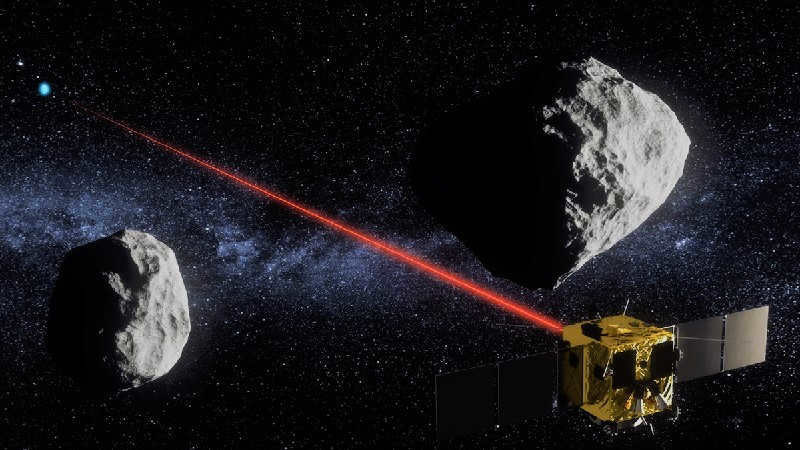
Indeed, the defense mechanisms against meteorites are primarily based on ideological principles. It is plausible that some of these methods will eventually come to fruition. For instance, the laser technique involves the utilization of a powerful laser to alter the trajectory of the celestial object, eliminating the necessity of space launches or other means.
However, it should be noted that the development of a laser with such immense power is yet to be achieved. Additionally, the implementation of a sophisticated cooling system would be obligatory. Consequently, at present, this approach remains primarily theoretical, due to the various requirements and the absence of a well-defined plan.
Nonetheless, it is fortunate that contemporary science is in a constant state of progress. Therefore, a solution to these significant challenges will undoubtedly be discovered.
The Price of Meteorites
Currently, the search for meteorites has evolved from a mere hobby or random discoveries into a full-fledged business venture. It has transitioned from being driven by curiosity to being driven by the potential for financial gain. Surprisingly, there is a significant demand for extraterrestrial rocks on our planet.
It is important to note that the attention towards celestial objects has been steadily increasing. Additionally, their market value has been on the rise.
According to various reports, the average price per gram of meteorites in Russia is as follows: stone meteorites – 65 rubles; iron meteorites – 140 rubles; and iron-stone meteorites (pallasites) – 1200 rubles.
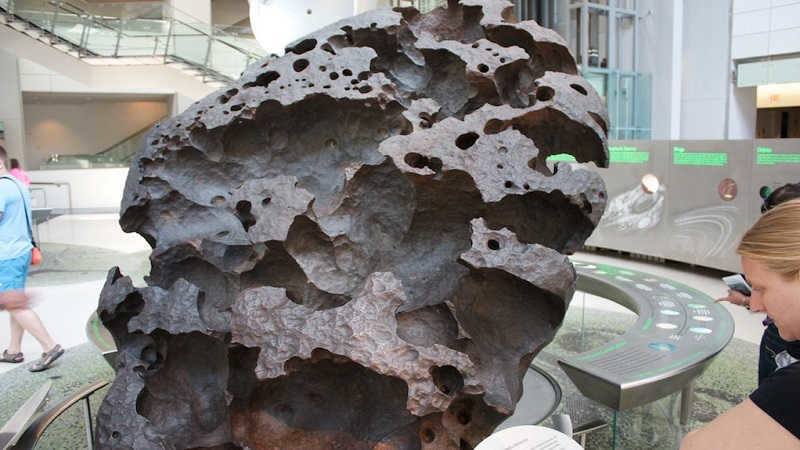
It is worth noting that the process of discovering a meteorite is quite achievable and not overly complicated. However, it is important to clarify that this applies to smaller fragments and minuscule particles such as sand. Given the fact that numerous extraterrestrial objects enter the Earth’s atmosphere on a daily basis, they are scattered across the entire planet. Consequently, they can be found in any location, as they are present all around us.
Scientists approximate that between 30 to 200 tons of meteoric material fall into the Earth’s atmosphere each day.
How to Search for Meteorites
Indeed, one cannot simply embark on a meteorite hunt without any preparation. However, why not give it a try? It is possible, of course. Although, it is unlikely that you will find anything substantial.
In order to locate these celestial treasures, you will need a few tools: a magnifying glass and a magnet. The magnifying glass will help you examine the details more closely, while the magnet will help attract any extraterrestrial visitors.
It is worth noting that most meteorites contain iron, which can be easily detected by a magnet. Of course, it is essential to be able to differentiate between a meteorite and ordinary rocks and other earthly formations.
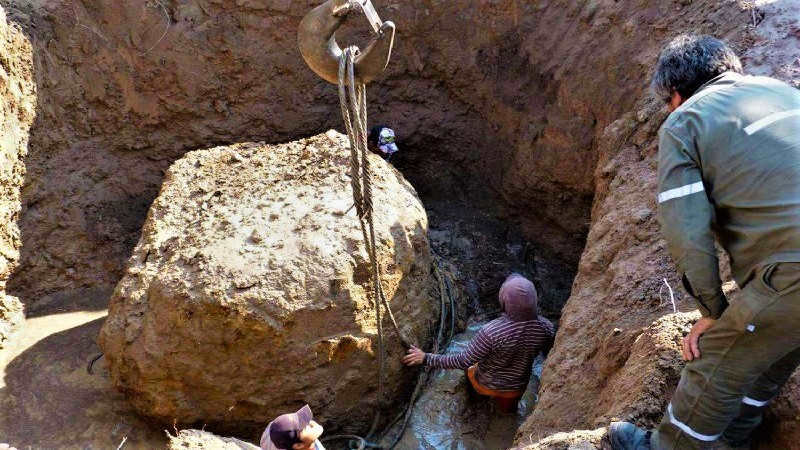
After preparing yourself, you can commence your search. It is important to note that the search can be conducted anywhere. For instance, you can search on the rooftop of your house. Gather all the objects you find there (you can even use a broom and dustpan), and submerge them in a deep container filled with water. Due to the dense and heavy nature of meteoritic material, it will sink to the bottom, while any floating debris can be disregarded. Then, carefully drain the water and examine what remains. It is possible that you might be fortunate enough to discover a small grain or particle of a meteorite. In the event that you do not find anything, do not lose hope and continue your search diligently.





